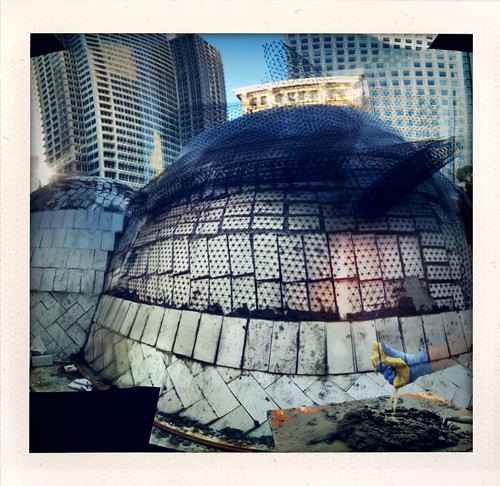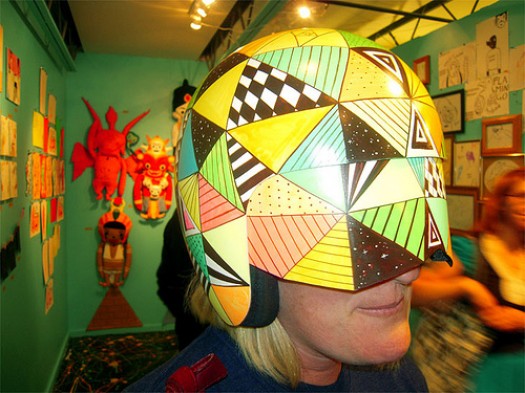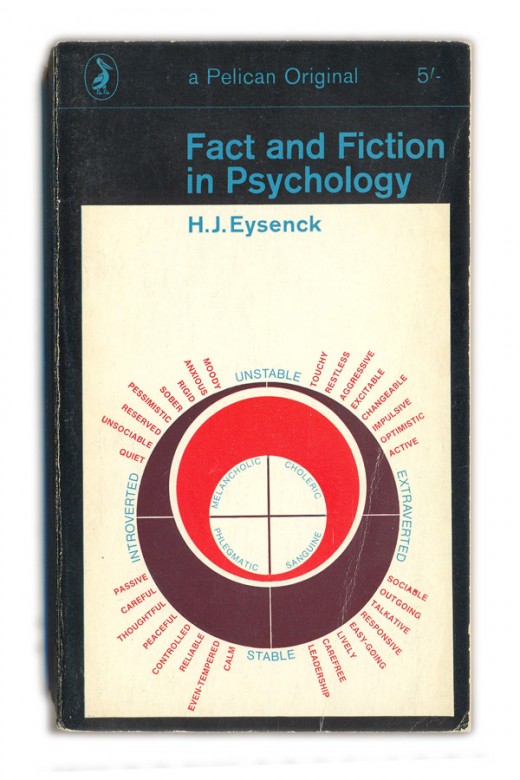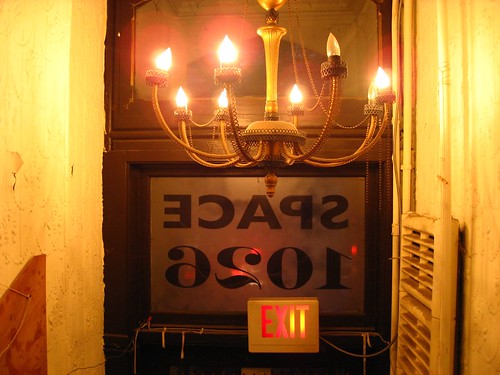My old friend Michael Ramage has a hand in this installation in the Yerba Buena Center for Art's Sculpture Garden. He's designing and building a pair of domes, made from layers of bricks and mortar and styled on ancient techniques. The artist behind it is Jewlia Eisenberg & Charming Hostess, and the vision is that the domes will be an outdoor venue for music, contemplation, and mind-expanding activities throughout the summer. I visited on Tuesday, and I was struck by the ways that each dome's oculus (fancy word for the open, circular window at the top of the dome) framed the surrounding sky and buildings. That perspective actually kind of made the generic buildings at 3rd and Howard appear to be somewhat cool. Didn't think that would be possible.
Category: inside art
Items relating to art that is hung on nice white walls, and/or erected in clean, well-lit places.
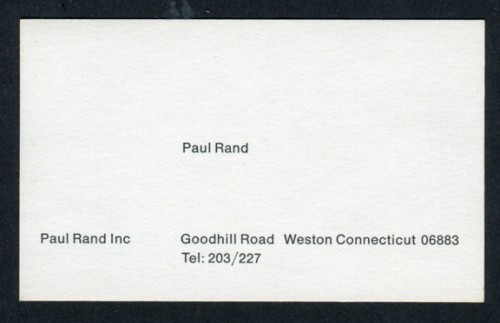
Can't imagine that it could get much better than this. Via amassblog.
Dream team

Saul Steinberg's cover for the first edition The Americans by Robert Frank. Publisher Robert Delpire: "The only point of disagreement was the cover. I insisted right away on using a drawing by Saul Steinberg, whom I had met and whose work I liked. Frank said, 'It's a book of photos, we could use a photo.' I told him, 'You can use a photo for the American edition, but let me use a Steinberg drawing.' But when I reprinted the book in 1986, I used a photograph because I had discovered, basically, that he was right."
Photographer Robert Frank is known for a few things, primarily The Americans, a ground-breaking book of photography published in the late 50's. He is also known for avant-garde film-making, e.g., Pull My Daisy, and his never-released Rolling Stones documentary with an unprintable name.We checked out SFMOMA's 50th anniversary retrospective of The Americans today, and I was astonished at another of Frank's skills: Grant-writing. In order to fund the gathering of the photos that became The Americans, he applied for a Guggenheim Fellowship. I've pasted his clear, simple, two-part essay below.
Part 1: Frank's brief summary of the proposal
To photograph freely throughout the United States, using the miniature camera exclusively. The making of a broad, voluminous picture record of things American, past and present. This project is essentially the visual study of a civilization and will include caption notes; but it is only partly documentary in nature: one of its aims is more artistic than the word documentary implies.
Part 2: The full statement of intent
I am applying for a Fellowship with a very simple intention: I wish to continue, develop and widen the kind of work I already do, and have been doing for some ten years, and apply it to the American nation in general. I am submitting work that will be seen to be documentation — most broadly speaking. Work of this kind is, I believe, to be found carrying its own visual impact without much work explanation. The project I have in mind is one that will shape itself as it proceeds, and is essentially elastic. The material is there: the practice will be in the photographer's hand, the vision in his mind. One says this with some embarrassment but one cannot do less than claim vision if one is to ask for consideration. "The photographing of America" is a large order — read at all literally, the phrase would be an absurdity. What I have in mind, then, is observation and record of what one naturalized American finds to see in the United States that signifies the kind of civilization born here and spreading elsewhere. Incidentally, it is fair to assume that when an observant American travels abroad his eye will see freshly; and that the reverse may be true when a European eye looks at the United States. I speak of the things that are there, anywhere and everywhere — easily found, not easily selected and interpreted. A small catalog comes to the mind's eye: a town at night, a parking lot, a supermarket, a highway, the man who owns three cars and the man who owns none, the farmer and his children, a new house and a warped clapboard house, the dictation of taste, the dream of grandeur, advertising, neon lights, the faces of the leaders and the faces of the followers, gas tanks and postoffices and backyards. The uses of my project would be sociological, historical and aesthetic. My total production will be voluminous, as is usually the case when the photographer works with miniature film. I intend to classify and annotate my work on the spot, as I proceed. Ultimately the file I shall make should be deposited in a collection such as the one in the Library of Congress. A more immediate use I have in mind is both book and magazine publication.
Frank was awarded a fellowship, which amounted to $3,600, and he used this to travel in a long loop around the US in 1955–6. That "more immediate use" that he refers to in the final sentence turned into The Americans, a stunning document that is every bit as interesting 50 years later. The exhibition is captured in an extended version of The Americans, including contact sheets and commentary.
I could use one of these right about now. Via these geniuses.
RFK funeral train / A breaking up
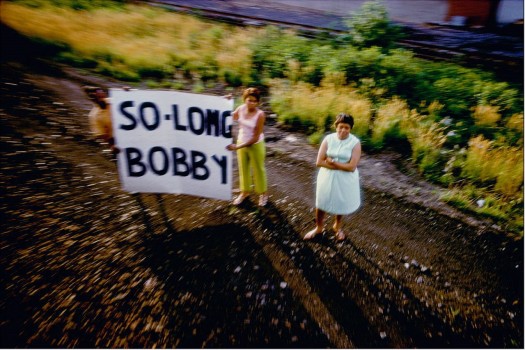
The New York Times recently ran some photos that were taken from the train carrying Bobby Kennedy's body between Washington to New York. The photos themselves are amazing documents of a nation in mourning, people from all walks of life lining the tracks, holding signs, saluting or just watching, but they're also beautiful — saturated and blurred, creating the sensation that things are moving too fast, that something is irresistibly barreling on. The photographer, Paul Fusco, narrates a slideshow on the New York Times site, and it's well worth a viewing. He's nicely describes the experience around the photos, and provides some insight into the mechanics (Kodachrome film, of course). He also mentions that he hadn't planned on taking pictures while on the train; he was simply traveling along with the coffin to take photos at the funeral.
The first thing I saw were hundreds of people on the platform … Fortunately, I just reacted. My instinct was: There's something going on, photograph it … [The train] was a moving platform. I couldn't change my view. I couldn't change my perspective. I had to just … grab it, when I could.
 "Everyone was there. America came out to mourn." Photos: Paul Fusco/Magnum Photos
"Everyone was there. America came out to mourn." Photos: Paul Fusco/Magnum PhotosFusco has a show that's currently at Danziger Project in New York, and a book coming out in the fall, too. Looks nice.
Books / Pelican covers
things magazine has amassed an incredible index of Pelican book covers from the 1930s through the 80s. The one above is from 1968. Check it.
Last Friday night was just another night in the penthouse of the Fairmont Hotel for Mara and I. We relaxed in seal-skin robes, shuffled around in baby polar bear ear fur slippers, snorted the finest powdered snow leopard pancreas, fed Kobe beef to the pigeons who delivered the New York Times piecemeal in tiny scrolls tied to their feet, and generally killed time. (While enjoying the Cooper holiday party). When we emerged from a blissful reverie, we noticed that the walls were covered with an unusual world map.
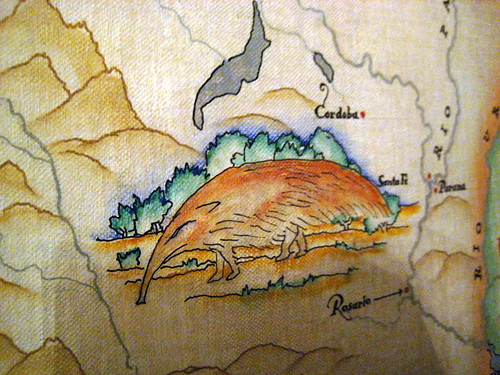 It was painted in 1927, by a guy named Robert Boardman Howard. A little poking around on the Internet reveals that his work is scattered across Northern California — sketches at the Merced post office, a design for the phoenix on Coit Tower, a relief in front of the Livermore post office.
It was painted in 1927, by a guy named Robert Boardman Howard. A little poking around on the Internet reveals that his work is scattered across Northern California — sketches at the Merced post office, a design for the phoenix on Coit Tower, a relief in front of the Livermore post office.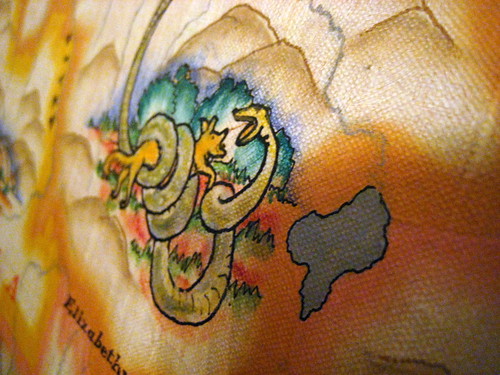 The Smithsonian did an interview with him in 1964, where he talks about another good NorCal project. "Then there was a small theatre up at Guerneville that I decorated. They gave me a free hand. I painted all the natives of Guerneville, their portraits, including the village dog. That was quite interesting. Good experience." Amen, brother.
The Smithsonian did an interview with him in 1964, where he talks about another good NorCal project. "Then there was a small theatre up at Guerneville that I decorated. They gave me a free hand. I painted all the natives of Guerneville, their portraits, including the village dog. That was quite interesting. Good experience." Amen, brother.
I was in Philadelphia last Thursday evening, and I discovered that I was staying near Space 1026, a studio/gallery near downtown. Some artists from 1026 had some cool work in a show at Yerba Buena a while ago, I walked over and spent a few minutes walking around as the residents were setting up for the place's 10th anniversary party.
It's got a pretty great vibe; part punk club, part workshop, part hobo village. Situated above some retail space near the bus station, there's a nice open space in the front, but the majority is sectioned off into seven or eight (or more) mostly small studios densely packed with art supplies, knick-knacks, bikes, and other crap. I didn't get to see much, but I took some pictures of the various hallways and spaces so check em out.
Lots of intriguing stuff at Clare Rojas's opening at Gallery Paule Anglim tonight. Woodland creatures, naked dudes in tai chi poses, an excellent video of Peggy Honeywell playing a slow sad song at a raging frat party filled with beer bongs and keg stands, Amaze, Barry McGee, and much, much more. Worth it.
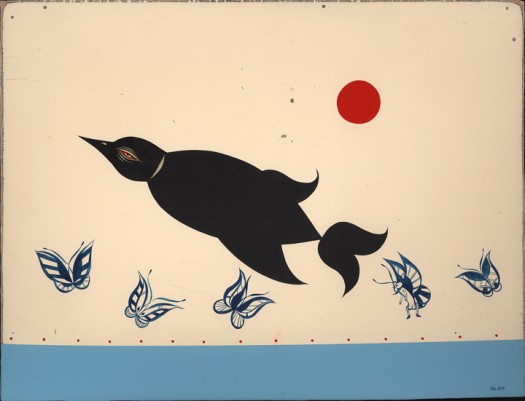 I call this one "It's Hard Out Here For a Penguin."
I call this one "It's Hard Out Here For a Penguin."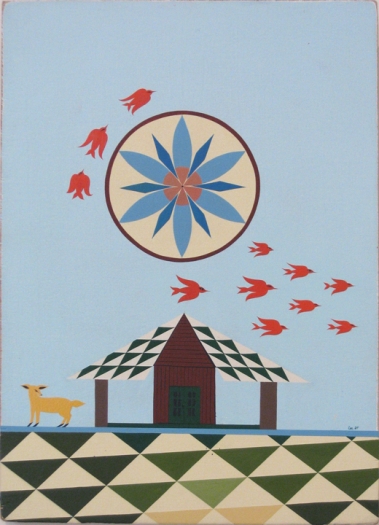 I think this one is untitled, but it should be called "Untitleable."
I think this one is untitled, but it should be called "Untitleable."
Gallery Paule Anglim is at 14 Geary in downtown San Francisco.
